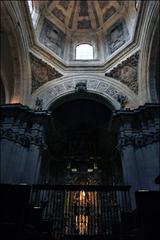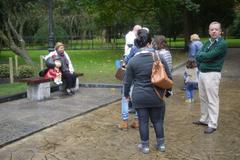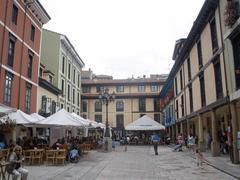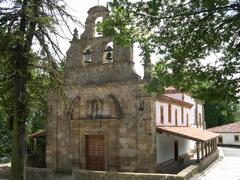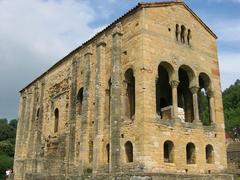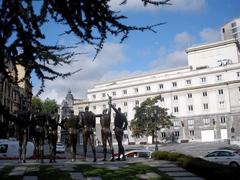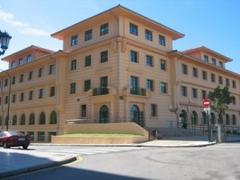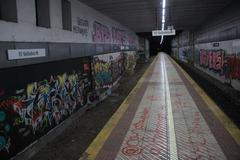
Archaeological Museum of Asturias: Visiting Hours, Tickets, and Guide to Oviedo’s Historical Sites
Date: 04/07/2025
Introduction: Discovering the Archaeological Museum of Asturias
Located in the heart of Oviedo’s historic center, the Archaeological Museum of Asturias is a gateway to understanding northern Spain’s rich archaeological and cultural legacy. Housed within the ancient Monastery of San Vicente—founded in the 8th century and later transformed with Renaissance and Baroque elements—the museum offers a journey through more than 300,000 years of Asturian history. Its diverse collections connect visitors to UNESCO World Heritage sites, from the prehistoric caves of Tito Bustillo to the region’s unique pre-Romanesque churches (Turismo Asturias; Museo Arqueológico de Asturias).
This guide provides all the essential information for planning your visit: opening hours, ticket details, accessibility, travel tips, highlights of the museum’s collections, and suggestions for exploring Oviedo’s historical surroundings.
Table of Contents
- Introduction
- Overview: History and Cultural Significance
- Visitor Information
- Museum Layout, Exhibits, and Visitor Experience
- Nearby Attractions and Itineraries
- Guided Tours, Special Events, and FAQs
- Visual and Digital Resources
- Conclusion
- Sources
Overview: History and Cultural Significance
The Archaeological Museum of Asturias serves as the principal institution for preserving and interpreting the region’s archaeological heritage. Established in 1845, it is one of Spain’s earliest archaeological museums. Its creation was driven by the need to safeguard Asturian artifacts threatened by antiquarian interest and to foster public education about the region’s past (Turismo Asturias). Over time, the museum’s collection has grown substantially, thanks to ongoing excavations at renowned sites like Tito Bustillo, El Buxu, the castros of Coaña and Chao Samartín, and Roman settlements in Gijón and Lugo de Llanera.
The museum is notable for its holdings of prehistoric art, Roman inscriptions, and medieval artifacts—including items that reflect the transition from prehistory through the Roman era to the formation of the Asturian Kingdom. Its home, the Monastery of San Vicente, is itself a monument to Asturias’s historical and architectural evolution. A major renovation in 2011 transformed the museum into a modern, accessible, and interactive facility, preserving the monastery’s heritage while introducing state-of-the-art exhibition spaces (Museo Arqueológico de Asturias).
Visitor Information
Visiting Hours
- Monday: Closed
- Tuesday to Saturday: 10:00 AM – 7:00 PM
- Sunday and Public Holidays: 10:00 AM – 3:00 PM
Please check the official website for potential changes during holidays or special events.
Ticket Prices
- General Admission: €5
- Reduced Admission: €3 (students, seniors, large families)
- Children under 12: Free
- Special Admission: Some temporary exhibitions may require an additional fee.
- Guided Tours: Available for groups and individuals upon request.
Tickets can be purchased onsite or reserved online via the official museum website.
Accessibility
The museum is committed to inclusivity:
- Wheelchair-accessible entrances, elevators, and restrooms.
- Tactile exhibits and Braille texts for visually impaired guests.
- Subtitled audiovisuals for hearing-impaired visitors.
- Audio guides in multiple languages.
- Assistance available upon request.
Directions & Parking
- Address: Plaza de Alfonso II el Casto, 33003 Oviedo, Asturias, Spain
- By Public Transport: Several city bus lines stop within a five-minute walk. The train station is a 15-minute walk or short taxi ride away.
- Parking: Limited street parking nearby; paid parking garages (San Francisco and Campoamor) are within easy walking distance.
Museum Layout, Exhibits, and Visitor Experience
Architectural Overview
The museum is located within the former Monastery of San Vicente, a building that embodies centuries of Asturian religious and architectural history. Renovations have preserved the original cloister, which now serves as a tranquil centerpiece for visitors.
The museum is arranged over four main floors, guiding visitors through a chronological exploration of Asturias:
- Ground Floor: Reception, temporary exhibition hall, introductory displays.
- First Floor: Prehistory and protohistory.
- Second Floor: Roman Asturias, late antiquity.
- Third Floor: Medieval Asturias, including the rise of the Asturian Kingdom.
Key Exhibits
Prehistory and Protohistory
- Paleolithic tools and cave art replicas, including artifacts from Tito Bustillo and El Sidrón caves.
- Neolithic ceramics and Bronze Age jewelry.
- Iron Age castro culture: hillfort models and Celtic-influenced objects.
Roman Asturias
- Roman inscriptions, funerary stelae, and villa reconstructions.
- Mosaics, ceramics, coins, and domestic items.
- Mining tools from Las Médulas, a UNESCO World Heritage Site (Las Médulas).
Late Antiquity and Early Middle Ages
- Visigothic, Suevic, and early Christian artifacts.
- Items linked to the Asturian monarchy, including coins and seals.
Medieval Asturias
- Pre-Romanesque art and architectural fragments from UNESCO-listed churches (UNESCO).
- Liturgical objects, reliquaries, and everyday medieval artifacts.
- Finds from Oviedo’s historic old town.
Temporary Exhibitions
The ground floor hosts changing exhibitions on recent discoveries and thematic topics, often in collaboration with other museums.
Interactive Features and Facilities
- Interpretive Resources: Bilingual Spanish/English signage, audio guides (Spanish, English, French), interactive displays, and tactile replicas.
- Educational Programs: Workshops, guided tours, and family-friendly activities throughout the year (Museo Arqueológico de Asturias – Actividades).
- Ambience and Facilities: Cloister café, museum shop, restrooms, lockers, and free Wi-Fi.
- Accessibility: Full compliance with accessibility standards and participation in the “Museos para Todos” initiative (Museos para Todos).
Nearby Attractions and Suggested Itineraries
Oviedo’s compact historic center invites visitors to combine their museum tour with nearby highlights:
- Cathedral of San Salvador: Gothic masterpiece with the Cámara Santa relic chamber.
- San Julián de los Prados Church: Pre-Romanesque and UNESCO-listed.
- Oviedo’s Old Town (Casco Antiguo): Characterful streets, plazas, and local cafes.
- Monte Naranco: Offers panoramic city views and access to Santa María del Naranco and San Miguel de Lillo.
Guided Tours, Special Events, and Frequently Asked Questions
Guided Tours & Special Events
- Guided tours in Spanish and English are available; advance booking recommended for groups.
- Regular temporary exhibitions, workshops, and family activities are scheduled year-round.
- Check the museum’s event calendar for updates.
Frequently Asked Questions (FAQ)
Q: What are the museum’s visiting hours?
A: Tuesday to Saturday, 10:00 AM–7:00 PM; Sunday and public holidays, 10:00 AM–3:00 PM; closed Mondays.
Q: How much is admission?
A: General admission is €5; reduced rates for students, seniors, and large families; free for children under 12. Some exhibitions may require a separate fee.
Q: Is the museum accessible?
A: Yes, with wheelchair access, tactile exhibits, and multilingual resources.
Q: Are guided tours available?
A: Yes, in both Spanish and English, with reservations recommended.
Q: Can I take photographs?
A: Non-flash photography is generally allowed, but some exhibitions may have restrictions.
Q: What else is there to see nearby?
A: The Cathedral of San Salvador, pre-Romanesque churches, Oviedo’s old town, and Monte Naranco are all within easy reach.
Visual and Digital Resources
- High-quality images and virtual tours are available on the official museum website, with descriptive alt tags for accessibility.
- Download the Audiala app for interactive guides, exhibition highlights, and augmented reality experiences.
- Follow the museum and Audiala on social media for event updates and virtual content.
Conclusion
The Archaeological Museum of Asturias is a cornerstone of Oviedo’s cultural and historical landscape—an essential destination for understanding the region’s evolution from prehistory to the Middle Ages. With thoughtfully curated exhibits, a commitment to accessibility, and its stunning architectural setting, the museum offers a deeply engaging experience for all visitors.
Enhance your visit by exploring nearby landmarks, joining guided tours, and engaging with the museum’s digital resources. For the latest information on visiting hours, ticketing, and special events, consult the official museum website and download the Audiala app for an enriched, interactive visit.
Plan your trip today and discover why the Archaeological Museum of Asturias is one of Spain’s most significant cultural treasures.
Sources
- Visiting the Archaeological Museum of Asturias: Hours, Tickets, History, and Travel Tips, 2025, Turismo Asturias (Turismo Asturias)
- Visiting the Archaeological Museum of Asturias: Hours, Tickets, Historical Insights, and Visitor Guide, 2025, Museo Arqueológico de Asturias (Museo Arqueológico de Asturias)
- Visiting the Archaeological Museum of Asturias: Hours, Tickets, and Guide to Oviedo’s Historical Treasure, 2025, Museo Arqueológico de Asturias (Museo Arqueológico de Asturias)
- Visiting the Archaeological Museum of Asturias in Oviedo: Hours, Tickets, and Local Heritage, 2025



